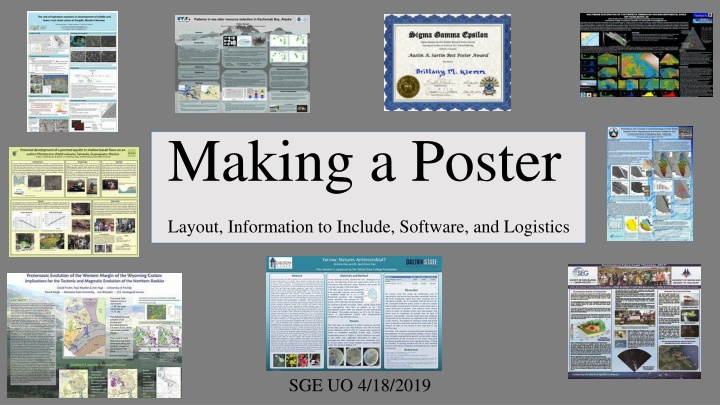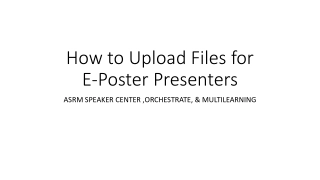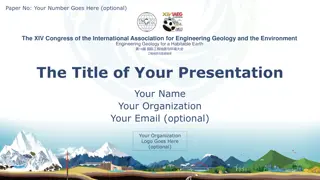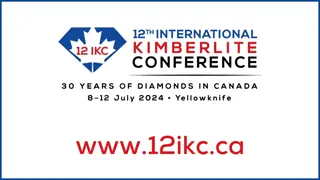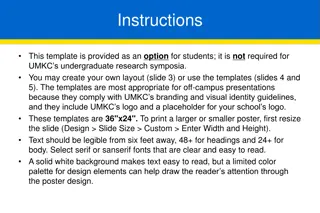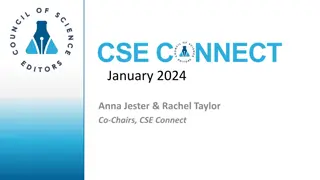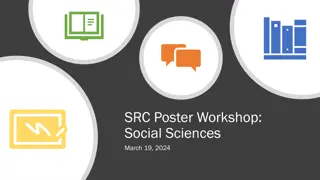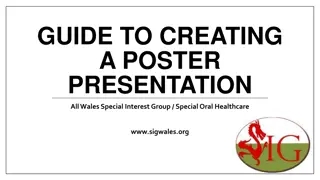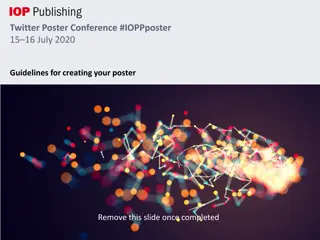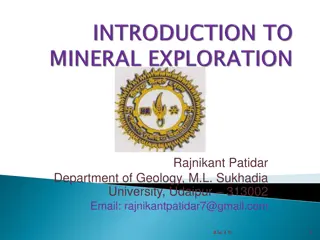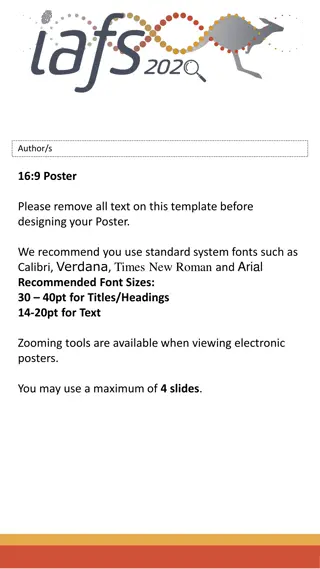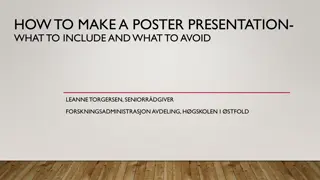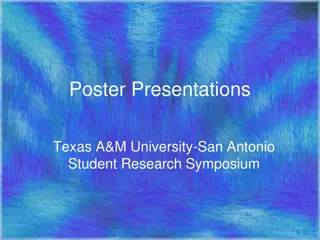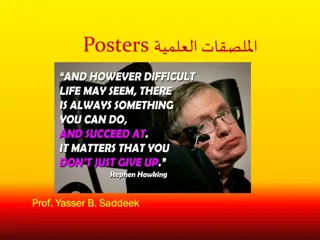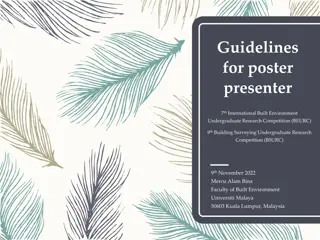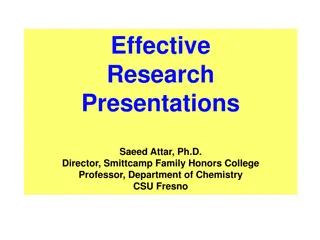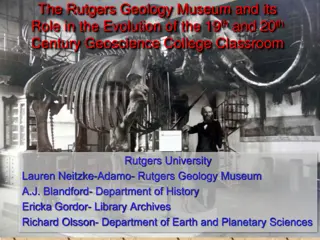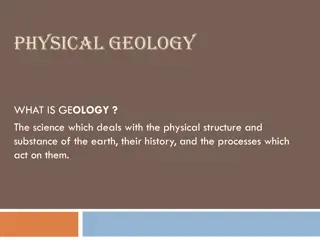Tips for Creating an Effective Geology Research Poster
Crafting a visually appealing and informative geology research poster requires attention to detail. Key elements for success include readability from a distance, a compelling title, clean layout with consistent fonts and colors, and the use of high-resolution images. Utilizing tools like Microsoft PowerPoint and Adobe Illustrator can streamline the design process. Tips on layout, title design, including essential information, and choosing appropriate software are crucial for delivering a successful geology research poster presentation.
Download Presentation

Please find below an Image/Link to download the presentation.
The content on the website is provided AS IS for your information and personal use only. It may not be sold, licensed, or shared on other websites without obtaining consent from the author.If you encounter any issues during the download, it is possible that the publisher has removed the file from their server.
You are allowed to download the files provided on this website for personal or commercial use, subject to the condition that they are used lawfully. All files are the property of their respective owners.
The content on the website is provided AS IS for your information and personal use only. It may not be sold, licensed, or shared on other websites without obtaining consent from the author.
E N D
Presentation Transcript
Image result for geology Research Poster Image result for geology Research Poster Image result for geology Research Poster Making a Poster Image result for geology Research Poster Image result for geology Research Poster Layout, Information to Include, Software, and Logistics Image result for geology Research Poster Image result for geology Research Poster Image result for geology Research Poster SGE UO 4/18/2019
What makes a good poster? Important info should be readable at 10 feet away Big, short, concise title, draws interest Bullets, numbering, and headlines make it easy to read. Clean layout, consistent use of fonts and color. Use only high resolution photos. https://s3.amazonaws.com/libapps/accounts/51759/images/libguide_posters-bad_example.jpg https://s3.amazonaws.com/libapps/accounts/51759/images/libguide_poster.jpg https://guides.nyu.edu/posters
Tools Available Microsoft and Adobe Microsoft Powerpoint Adobe Illustrator Takes less time More people are used to it Don t Use Photoshop More difficult to learn Image result for powerpoint Image result for illustrtor Less capable / inflexible Colors on screen are not necessarily what are printed More control over location of objects Colors remain true when printed Both can be set to whatever size specs are necessary
Layout - one method of many Use Grids to keep material aligned Column format Try to keep ~ 40 % of your poster empty of text and images Limit use of boxes and lines Group similar topics together Font Size: >36 for sub headings, >24 for main body, >50-125 Title (depending on font) 1 3 2 4 Background: For professional poster sessions, one color or gradients Photo backgrounds become distracting
Title Boldfaced, not all caps Only essential words, or a catchy title. Make it accessible to others not in your sub-field. Font size > 50 Unless going presenting at EXTREMELY niche conference, don t do this
What to Include? Headings Bold, grab the readers attention. Possible to have darker boxes surrounding them, make them distinctive Introductions Short background of the topic to set the context and state the main objectives of your work. Could include background, research questions, scientific objectives,
What to Include?- Continued Image result for poster methods Methods (space permiting) Basic parameters target sample, setting, duration of study, techniques, equipment used. Illustrator Figures tend to help the audience understand Results Data, figures, centered if possible Make this the highlight of the poster, the largest section of it. Use the figures to get the message you want across. Use colors to help Don t include raw data Use figure legends, scale bars, consistent axes
What to Include? - Continued Future Work Whatever work was not done, or will be done, highlight in the F.E. section. What questions were not answered that you hoped would be answered? References Cite all references that helped with the research, and cite according to the sty
Rules about Figures Use meaningful, high quality images Adjust the color and contrast to make it pop Crop or edit images to highlight what is relevant Caption all figure Label directly on figures to clarify, but don t overdo it. Use bold lines, to be seen from > 5 ft Balance images so they are not all on one side
Color Scheme www.colorschemer.com/online.html Use websites like the one above to pick colors that work well together. Blue on Red = Bad Yellow on White = Bad Red on Blue = Bad Look into colors that are visible for people with color-blindness Don t do this http://hsp.berkeley.edu/sites/default/files/ScientificPosters.pdf
Other stuff Always acknowledge funding sources Always give credit to collaborators Have photos be at least 150 dpi, but not more than 300 dpi Save photos as jpg or png Images and graphs say more than words Make text left aligned Print out a letter sized draft to test it. Serif Font s are easiest to read Ask yourself: Can you read the type, is it too busy, are the colors good? Include captions on all figures.
How To Print? Image result for poster printer At the UO: Geology Department has one if your professor is willing to pay. Printing services offered at Lawrence Hall Print At Least the day before travel begins. Better to print up to a week out, there tends to be a rush for printing before a conference. For UROP Undergrad Prez s, 3-4 days in advance should suffice https://blogs.uoregon.edu/designtech/eugene-output-room/poster-printing/
https://www.liverpool.ac.uk/media/livacuk/computingservices/printing/making-an-impact-with-your-poster.pdfhttps://www.liverpool.ac.uk/media/livacuk/computingservices/printing/making-an-impact-with-your-poster.pdf
Sources of information and further reading. Websites on academic poster creation http://clt.lse.ac.uk/poster-design/ http://gradschool.unc.edu/student/postertips.html http://www.spfldcol.edu/homepage/dept.nsf/BC81220B343BE6788525738E005FDA74/F0BB3C96C5ED 8A898525754700505502 http://www.ncsu.edu/project/posters/NewSite/ http://saw.uwaterloo.ca/poster/ http://www.cns.cornell.edu/documents/ScientificPosters.pdf http://www.kcl.ac.uk/library/researchsupport/disseminate/posters.aspx http://www2.napier.ac.uk/gus/writing_presenting/academic_posters.html http://www2.le.ac.uk/offices/careers/pgrd/resources/designing-poster/designing-poster http://prezi.com/0e1ftr5f7zlz/designing-an-academic-poster/ Websites on Colour Theory Color Theory for Designers : Smashing Magazine Jan 28th 2010 : http://www.smashingmagazine.com/2010/01/28/color-theory-for-designers-part-1-the-meaning-ofcolor/ Colormatters : http://www.colormatters.com/color-and-design/basic-color-theory Tiger color: http://www.tigercolor.com/color-lab/color-theory/color-theory-intro.htm Artyfactory : http://www.artyfactory.com/color_theory/color_theory.htm
